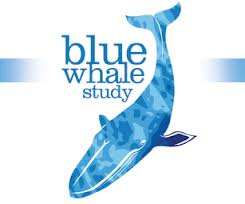|
Blue Whale Study aerial surveys, southern Australia, 2007-2012
Blue Whale Study Inc.
Dataset credit
Blue Whale Study Inc.
|
Contacts
| Role | Name | Organization | |
|---|
| Primary contact |
Peter Gill |
Blue Whale Study Inc. |
 |
| Data entry |
Ei Fujioka |
Duke University |
 |
|
Citation
Gill, P. 2015. Blue Whale Study aerial surveys, southern Australia, 2007-2012. Data downloaded from OBIS-SEAMAP (http://seamap.env.duke.edu/dataset/1281) on yyyy-mm-dd. Halpin, P.N., A.J. Read, E. Fujioka, B.D. Best, B. Donnelly, L.J. Hazen, C. Kot, K. Urian, E. LaBrecque, A. Dimatteo, J. Cleary, C. Good, L.B. Crowder, and K.D. Hyrenbach. 2009. OBIS-SEAMAP: The world data center for marine mammal, sea bird, and sea turtle distributions. Oceanography. 22(2):104-115.
|
Abstract
Wind-forced cold water upwelling occurs seasonally along the continental shelf of south-east Australia, where pygmy blue whales aggregate to forage. Seasonality and variability are apparent for both blue whale encounter rates and upwelling, within and between seasons. Here we quantify upwelling variability over 11 seasons (2001/02 to 2011/12) and relate it to blue whale encounter rates. Two indices, cumulative wind stress (Intensity) quantifying physical forcing, and surface chlorophyll-a (chl-a) quantifying the ocean’s biological response, revealed variability in upwelling at a variety of temporal scales. Within seasons, upwelling Intensity peaked during February, and chl-a during February–March. Blue whale encounter rate from 52 aerial surveys was modelled against upwelling indices and the climate signal SAM (Southern Annular Mode), at individual survey- and aggregated season-levels, using General Additive Models (GAMs). Survey-level GAMs showed that encounter rate increased with increasing chl-a, and with increasing upwelling Intensity to a point beyond which further increases in Intensity resulted in declining encounter rates. This indicated the importance of productivity, as well as relaxation of upwelling, in producing optimal blue whale foraging conditions. In exploratory season-level models, a strong influence of SAM was apparent, with higher encounter rates associated with positive SAM during the preceding 12 months. Including chl-a improved the model, indicating that both broad-scale climatic signals inherently incorporating environmental variability and uncertainty, as well as more proximal regional factors may influence blue whale occurrence in the study area. Measuring the complex relationships between whale occurrence and upwelling is complicated by the fact that the population of blue whales using the Bonney Upwelling is open, and moves between alternate foraging areas. The findings were interpreted in the context of blue whale foraging ecology in this system.
|
Purpose
Relate variability in blue whale relative abundance to variability in upwelling off southern Australia
|
Supplemental information
N/A
|
References
Pirzl, R.; Gill, P.; Morrice, M.; Garcia-Rojas, M.; Levings, A.; Van Ruth, P. 2015. Blue Whale Occurrence Related to Variability in a Coastal Upwelling System. PLOS ONE (submitted).
|
Attributes
Overview
This section explains attributes included in the original dataset.
OBIS-SEAMAP restricts the attributes available to the public to date/time, lat/lon and species names/counts only.
Should you need other attributes described here, you are encouraged to contact the data provider.
Attributes described below represent those in the original dataset provided by the provider.
Only minimum required attributes are visible and downloadable online. Other attributes may be obtained upon provider's permission.
Attributes in dataset
| Attribute (table column) | Description |
|---|
| oid | Unique ID number (generated by OBIS-SEAMAP) |
| species | Scientific name |
| sp_tsn | Taxonomic Serial Number added by OBIS-SEAMAP |
| obs_date | Date of observation |
| obs_time | Time of the observation (local time zone) |
| longitude | Longitude in decimal degrees |
| latitude | Latitude in decimal degrees |
| obs_count | best estimate of number of animals |
| geom | Geometry field added by OBIS-SEAMAP |
|
|

| OBIS-SEAMAP ID | 1281 |
| Seabirds | 0 |
| Marine mammals | 87 |
| Sea turtles | 0 |
| Rays and sharks | 0 |
| Other species | 0 |
| Non spatial | 0 |
| Non species | 0 |
| Total | 87 |
| Date, Begin | 2007-11-09 |
| Date, End | 2012-03-28 |
| Temporal prec. | 111110 |
| Latitude | -39.41 - -37.53 |
| Longitude | 139.52 - 143.36 |
| Coord. prec. | 3 decimal digits |
| Platform | Plane |
| Data type | Animal sighting |
| Effort | N/A |
| Traveled (km) | 0 |
| 0 |
| Contr. through | |
| Registered | 2015-06-03 |
| Updated | 2015-06-04 |
| Status | Published |
Sharing policy |
CC-BY (Minimum) |
| Shared with |
OBIS
GBIF (via DOI) |
| See metadata in static HTML |
| See metadata in FGDC XML |
| See download history / statistics |
|

